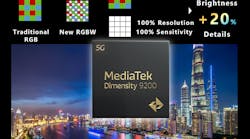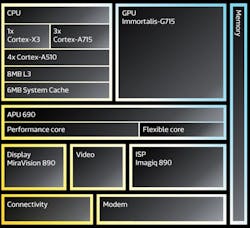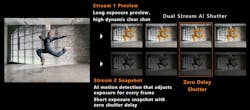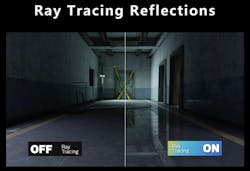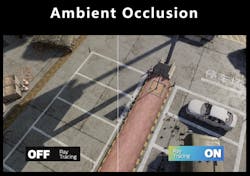What you’ll learn
- What’s inside the MediaTek Dimensity 9200.
- Why this new SoC is so significant.
With MediaTek’s Dimensity 9200, which packs in just about everything except the kitchen sink, you can see everything in 3D ray-traced displays courtesy of its Immortalis-G715 GPU (Fig. 1). It needs TSMC’s second-generation 4-nm transistor process to keep the chip to a manageable size while keeping power down, and still deliver a high-performance mobile platform.
Designing an SoC is a balancing act to simplify external requirements yet not provide too much support that might be underutilized. This is highlighted in the Dimensity 9200’s processor cores, which include a high-performance 64-bit, 3.05-GHz Arm Cortex-X3, three Cortex-A715s, and four low-power Cortex-A510s. The cores support Arm’s second-generation Armv9 architecture. The combination of cores enables the system to switch between low-power operation and high performance while dynamically balancing these requirements.
These cores share an 8-MB L3 cache and a system-wide 6-MB cache. We will get to some of the other features like the machine-learning (ML) acceleration provided by the artificial-intelligence processing unit (APU 690), the ray-tracing support provided by the Immortalis-G715 GPU, and the RGBW support in the Imagiq 890 image signal processor (ISP) (Fig. 2).
The chip includes LPDDR5X support up to 8533 Mb/s. The JEDEC Universal Flash Storage (UFS) 4.0 interface standard specifies transfer speeds up to 23.2 Gb/s/lane. In addition, the UFS system can handle multi-circular queuing (MCQ).
Wireless communication is part of this SoC’s mix. It is Wi-Fi 7-ready, which is more forward-looking as the dearth of Wi-Fi 7 access points will be remedied in the near future. Wi-Fi 6 (802.11ax) is the dominant player at the moment. The newer 802.11be will double the bandwidth and employ higher spatial streams compared to 802.11ax, with a theoretical maximum throughput of 46 Gb/s. Wi-Fi 7 supports a maximum channel size of 320 MHz and modulation schemes up to 4096 QAM with enhanced orthoganol frequency-division multiple access (OFDMA).
5G support in the chip includes millimeter wave (mmWave) and sub-6-GHz. It uses smart beamforming to provide 25% better performance than conventional beamforming approaches. The system is expected to deliver 7.9 Gb/s in peak performance. Of course, there’s support for Bluetooth 5.3 as well as Bluetooth LE Audio and Auracast.
RGBW (red, green, blue, and white) LEDs have been implemented in lighting applications for some time; they provide flexible color presentation along with bright white when needed. This also can be done with displays that support RGBW, but it requires display controllers that can handle the transformation from RBG normally used internally by applications to something the hardware can deliver. The ISP Imagiq 890 manages this task as well as other image-processing chores (Fig. 3).
The ISP has more tricks, including the ability to take advantage of the APU 690 when processing a dual video stream (Fig. 4). One stream is used as a preview; AI support uses the other to adjust exposure on each frame. The idea is to utilize the two to deliver crisp photos that have no blur, which isn’t possible with conventional cameras and image processing.
The GPU’s ray-tracing support will be a boon to gamers and could have implications in the future for augmented and virtual reality (AR/VR). Ray tracing has been pushed by PC and console systems, where adding higher-performance GPUs to handle this feature isn’t as limited by space and power as is the case with mobile devices. Still, with the right hardware like MediaTek’s GPU, it’s possible to do ray tracing in real-time without blowing the power budget.
Ray tracing essentially follows light through reflections and refractions based on the virtual environment being presented. Reflections tend to be the obvious difference when showing off ray tracing (Fig. 5). The alternative is flat, unchanging backgrounds from a lighting perspective.
Things are a bit more subtle but still noticeable when ambient occlusion comes into play (Fig. 6). This is a distinct difference, but we tend to fill in the blanks when viewing images. When pointed out, we can identify the differences and will note that the overall feel of the image is better when these occlusions are presented to us via a ray-traced GPU.
Soft shadows are yet another affect that’s available with ray-tracing support (Fig. 7). For many, this may be more obvious than ambient occlusions. However, they’re still a subtle change that provides a higher-accuracy rendering of a scene. This and other ray-tracing features create more realistic presentations, making it harder to differentiate between a virtual environment and the real world.
MediaTek has included a number of major enhancements in its SoC, many of which are the incremental improvements that have been showing up in standards and research. For example, the APU provides mixed precision support with FP16 and integer weights that deliver more accurate results faster using less power.
MediaTek is one of many companies targeting the mobile market. We can expect similar configurations from the competition, but this firm has set the bar high.
